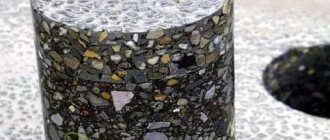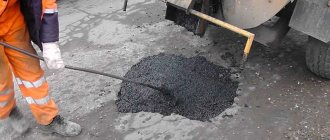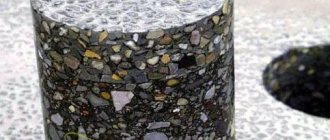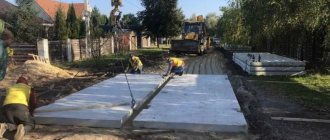Beton-House.com
Website about concrete: construction, characteristics, design. We combine the experience of professionals and private craftsmen in one place
The process of laying asphalt concrete pavement
SNIP for asphalt concrete pavement construction 3.06.03-85 came out back in the 80s of the last century. But today most of this document remains relevant.
In 2012, a new set of rules was released under the number 78.13330.2012, which updated the previously mentioned document to modern requirements. This is exactly what we will look at in today’s article to find out what asphalt concrete is and how it should be laid correctly.
- Development of embankments, excavations and foundation creation
- Preparation of mixtures
How is the asphalt surface on roads constructed?
The upper part of the road surface is asphalt. It is constantly exposed to external factors, so when laying it it is important to follow clear instructions so that it lasts a long period of time. A quality foundation is the key to success. The thickness of the asphalt layer is no less important. If the area is ready for asphalt laying work, it will be laid with high quality, which means that the service life of the material will increase.
Equipment used
The absence of heavy road equipment during manual repairs or construction of new roads implies that specialized road construction equipment will be used during the work.
The most commonly used equipment in manual construction and repair technology includes:
- Seam fillers. This type of equipment is primarily used for filling maps and seams with bituminous materials during pothole repairs. The installations provide melting, mixing and heating of mixtures, and pouring with strict control of the amount of material used.
- Joint cutters. Convenient and mobile equipment ensures fast and high-quality cutting of cards.
- Asphalt dispensers. Small manual installations have sufficient productivity to uniformly apply EBE to the crushed stone layer when preparing the base and into the card cavity in the repaired area.
- Vibrating plates. One of the most important steps in preparing the base, laying the covering and restoring damaged areas is high-quality compaction, achieved through the use of vibrating plates. In some cases, for example, when repairing small areas, a vibrating plate can be successfully replaced by a vibrating rammer.
- Thermal spear. This type of installation is used to clean and dry cards and cracks before repairs.
- Hand-held travel tool. When laying ABS manually, auxiliary tools are often used: carts for transporting cast asphalt, rakes for distributing and leveling the material, etc.
The presented range of equipment and tools, as well as various materials for road construction, can be purchased at competitive prices from a leading company. We offer our customers a wide range of high-quality products and ship orders to all regions of Russia.
What role does the base play?
The foundation is the base that will primarily provide drainage of water, rain and groundwater. Another function of the base is to distribute pressure on the asphalt, while as much of the area as possible should be used. It should also be said that the base is an excellent way to level out all the unevenness (this includes holes, bumps) so that the upper surface lies more evenly. In addition to leveling, the base helps prevent the appearance of these same irregularities after laying the asphalt.
What to use for the base? There are a huge number of materials, the most common ones are presented below:
- Crushed stone.
- Concrete.
- Brick fight.
The thickness of the asphalt layer will, of course, depend on the material taken as the base. The thickness also depends on operating conditions, which are often harsh. For example, the thickness of the asphalt pavement should be greater if the base is broken brick or crushed stone. This is due to the fact that the above materials are not as rigid as concrete. It follows from this that when using concrete, asphalt can be thinner.
Asphalt concrete pavement: general information
Asphalt concrete pavement: general information
The first asphalt concrete pavements were built in Babylon 600 BC. The construction of pavements using bitumen resumed only in the 19th century in Western Europe and then in the USA. The first section of asphalt concrete pavement in Russia was built on Volokolamsk Highway in 1928.
Asphalt concrete pavement has a number of positive properties and high transport and operational indicators: slow wear under the influence of heavy vehicles; relatively high strength and resistance to climatic factors and water; hygiene (does not create dust and is easy to clean from dust and dirt); ease of repair and strengthening of the coating.
Asphalt concrete pavement is laid on roads with a longitudinal slope of up to 60 ppm. The transverse slope is prescribed within 15-20 ppm.
Asphalt pavement designs are constantly changing due to the fact that traffic loads and traffic intensity are constantly increasing. Even 20-30 years ago, two-layer asphalt concrete pavements with a thickness of 10-12 cm on a crushed stone base of 18-25 cm were used on roads of high categories. Now such structures are suitable only for roads of lower (IV and V) categories, and on roads of categories II and I, the structures have become more powerful; at the base, thin (rolled) concrete with a thickness of 20-35 cm is increasingly used, and the total thickness of the laid asphalt is equal to 18-25 cm.
The service life of asphalt concrete pavements depends not only on the quality of the asphalt concrete, but also on the design of the road pavement. Asphalt concrete pavements of the same quality work differently on different substrates. Thus, in asphalt concrete pavements laid on bases made of monolithic cement concrete, cracks appear due to the thermophysical incompatibility of the coating and base materials, i.e., seams and cracks in cement concrete bases are repeated in asphalt concrete pavements.
Crushed stone foundations do not have this drawback; however, they are subject to uneven shrinkage occurring due to the mutual movement of crushed stone grains under the influence of repeated exposure to transport loads.
In relation to the selected road pavement design, it is necessary to select the type of asphalt concrete mixture. Pavements made from asphalt concrete mixtures should be installed in dry weather. Laying asphalt (paving) should be done at an ambient temperature of at least +5oC. Laying asphalt (pavement) can be done either mechanically, using an asphalt paver, or manually.
Filling and restoration of roads to holiday villages and garage cooperatives, roads with light traffic, asphalt road crumbs is a progressive method of road restoration. Due to its low cost and higher resistance to destruction than crushed stone and sand. Asphalt road crumbs have a higher density and are saturated with bitumen, which serves as an additional connecting link and sealing element, which allows the road to last much longer.
The best material for filling roads inside holiday villages and garage communities is asphalt chips. The advantage of asphalt chips is that they are laid much denser than sand and crushed stone. Asphalt crumbs, after being dumped, are rolled away by car wheels to such an extent that they become like asphalt. A road covered with asphalt chips is more resistant to erosion and other damage caused by water. The bitumen present in the crumbs serves as an additional binding and compacting element, which allows the road to last much longer than a road made of sand and crushed stone.
Technology of filling and restoration of unpaved roads:
Before laying asphalt chips, leveling is carried out, using a motor grader to knock down road unevenness, profiling the base, achieving the required evenness. After an even base layer has been achieved, the road crumbs are leveled along the entire road and the slopes are profiled. Achieving evenness of the coating with the same layer thickness. At the final stage, compaction is carried out using a road roller, thereby achieving high density and resistance to erosion and other damage under the influence of water.
After the road roller has compacted the surface, the new road is ready for use.
Before installing the base, it is necessary to install side stones and curbs. The bases for asphalt concrete pavements are made from crushed stone, slag, broken bricks, and other waste obtained from the dismantling of buildings and structures. Crushed old asphalt concrete (asphalt chips) is also used as a base material. The thickness of the base is usually 10-15 cm, depending on the properties of the underlying soil. The base material is leveled with a layer of the required thickness and then compacted with rollers with a scattering of stone or slag fines for crushing and decluttering.
The thickness of the asphalt concrete pavement is usually taken to be 3-4 cm. At the entrances to neighborhoods and courtyards, the thickness of the asphalt concrete layer is raised to 5 cm or more. Sandy or fine-grained asphalt concrete mixtures are used to construct sidewalk surfaces. Vibratory plates or small-class rollers are used to compact asphalt concrete.
Asphalting a sports ground
The asphalt base is built for a special sports surface on tennis courts, volleyball, basketball and other sports grounds. The installation of such a foundation includes a set of works:
- Excavation work (preparing the “trough”). Excavation and removal of soil to the required height, usually to the height of the crushed stone base. Layout, leveling the soil inside the trough; Installation of side stones, curbs and a drainage system around the perimeter of the site; Construction of a sand base 10-20 cm thick if the soil contains clay; Construction of a crushed stone base 15-18 cm thick. From crushed stone fractions 40x70 and 20x40. Can be used instead of crushed stone fr. 40x70, black crushed stone, and on the top layer - fine asphalt chips. It is advisable, to increase the reliability of the crushed stone base, to perform additional declinging by screening. Installation of embedded parts for racks; The top layer is made of a fine-grained asphalt concrete mixture of type “G”, with a total thickness of 8 cm. The asphalt is laid in two layers of 4 cm. To drain water from the surface of the court, the base must be set to a slope of 0.5 - 1 ‰ on the short side; Due to the specifics of the asphalt laying technology, it is impossible to achieve ideal evenness of the base. Therefore, before laying the sports surface, it is necessary to level the base with special mixtures.
Laying in an embankment and soil compaction are carried out during planning work, construction of various embankments, backfilling of trenches, foundation cavities, etc. Compaction is carried out in order to increase the bearing capacity of the soil, reduce its compressibility and reduce water permeability. The compaction can be superficial or deep. In both cases it is carried out by mechanisms.
There is soil compaction by rolling, tamping and vibration. The most preferable method of compaction is the simultaneous transfer of various influences to the ground (for example, vibration and rolling), or combining compaction with another work process (for example, rolling and vehicle movement, etc.).
To ensure uniform compaction, the dumped soil is leveled with bulldozers or other machines. The greatest soil compaction with the least amount of labor is achieved at a certain optimal moisture content for a given soil. Therefore, dry soils must be moistened, and waterlogged soils must be drained.
The soil is compacted in sections (grips), the dimensions of which should provide a sufficient scope of work. Increasing the scope of work can lead to drying out of the soil prepared for compaction in hot weather or, conversely, to waterlogging in rainy weather.
The most difficult thing is to compact the soil when backfilling the sinuses of foundations or trenches, since the work is carried out in cramped conditions. To avoid damage to foundations or pipelines, the adjacent soil to a width of 0.8 m is compacted using vibrating plates, pneumatic and electric tampers in layers 0.15...0.25 m thick. More productive methods, for example, self-propelled vibrating plates and others, are used when compacting backfill under the floors.
It is recommended to compact embankments with a large area using trailed or self-propelled smooth or pad rollers, as well as compacting machines in a closed circle.
The penetrations of soil compaction machines are made with a slight overlap to avoid missing uncompacted soil. The number of penetrations in one place and the thickness of the layer are set depending on the type of soil and the type of soil compacting machine or are established experimentally (usually 6...8 penetrations).
Embankments that do not have high requirements for soil density can be compacted by vehicles during the soil filling process. The work scheme is drawn up so that the loaded vehicle moves along the dumped layer of soil.
Unlike ordinary concrete, cement-crushed stone mixtures contain significantly less cement and can be compacted by the static action of self-propelled rollers with smooth rollers. A base of lean concrete is laid over a technological layer of compacted crushed stone, cement soil or a sand-gravel mixture 10-15 cm thick. On a base of lean concrete on highways with heavy traffic, a two-layer asphalt concrete coating with a total thickness of 8-12 cm is laid, on other driveways and On roads, a single-layer asphalt concrete coating with a thickness of at least 10 cm is laid over a layer of lean concrete. The lean concrete is laid in the base using a concrete paver, crushed stone paver or using small-scale mechanization. The mixture is distributed in a layer of up to 20 cm and immediately compacted, first with light and then with heavy rollers until the traces of rolling completely disappear.
The construction of an asphalt concrete pavement over lean concrete can be done after it has been compacted or after 2-3 days. In the latter case, the base surface should be treated with bitumen emulsion in two layers. The total emulsion consumption is 0.7 kg per 1 m2 of base. The construction of foundations made of lean concrete significantly reduces labor costs, as well as the start time for laying asphalt concrete. Temperature transverse joints are installed in lean concrete foundations. The distance between them is taken from 20 to 40 m, depending on the air temperature when laying the concrete mixture, the grade of lean concrete and the type of asphalt concrete pavement. The seams are cut with special cutters or arranged by laying spruce or pine boards into the base.
Asphalt reinforcement as a way to increase its durability
The issue of road surface reinforcement is by no means idle, since the bulk of roads and streets are covered with asphalt concrete, and its often deplorable condition and rapid destruction within several years are familiar to everyone who moves on their own or municipal wheels.
The quality of asphalt paving and the service life of asphalt concrete depend both on the quality of the base on which it is laid, and on the properties inherent in the very nature of the asphalt concrete pavement.
Asphalt concrete pavements, which have good resistance to short-term loads, have low tensile strength during bending and insufficient distributing capacity when a load is repeatedly applied. Therefore, fatigue and reflected cracks that arise during the operation of an asphalt concrete pavement, developing intensively, lead to its premature destruction.
For a long time, all over the world, the service life of asphalt concrete pavement has been increased by reinforcing it with geogrids. Today on the market there are geogrids made of fiberglass, polyester, basalt fibers and a number of others.
Based on the results of numerous laboratory studies and operating experience, the following requirements are imposed on reinforcing geogrids:
- the modulus of elasticity of the reinforcing material must be greater than the modulus of elasticity of asphalt concrete in order to absorb tensile forces similar to what happens in reinforced concrete; the adhesion between asphalt and the reinforcing material must be very good in order to distribute tensile stresses in the reinforcement material into adjacent areas of the asphalt concrete coverings. In this case, two important factors that influence the strength of this adhesion must be taken into account: the difference between the coefficients of thermal expansion of asphalt concrete and the reinforcing material should be as small as possible, since temperature changes cause secondary local stresses at the point of their connection, which can exceed the limit values, and the system will stop working as a whole. An example is the excellent behavior of reinforced concrete, where steel and concrete have the same coefficients of thermal expansion; the elastic modulus of the reinforcement material should not exceed the elastic modulus of asphalt concrete by several orders of magnitude. This is explained by the fact that, being an elastic-plastic material, asphalt concrete under transport (dynamic) load behaves like an elastic material, perceives stress and redistributes the load over a large area of the underlying layers together with the reinforcing material. If you use too rigid reinforcement, the main part of the tensile stresses will be absorbed by it. These stresses must be transmitted into the asphalt layers through adhesive forces, and a very large area of reinforcement embedding in the asphalt would be required so that the stresses do not exceed the adhesive forces of the reinforcement with the asphalt.
| Characteristics of some materials and finished products | |
| Name | Modulus of elasticity, N/mm2 |
| Asphalt | 1000 – 7000 |
| Concrete | 20000 – 40000 |
| Steel | 200000 – 210000 |
| Fiberglass | 69000 |
| Polyester fiber | 12000 – 18000 |
| Hatelit polyester geogrid strands | 7300 |
| Strands of basalt geogrid | 35000 |
Analyzing the data presented above from the positions stated above, one can understand why materials such as glass, steel or basalt work worse when paired with asphalt concrete than polyester.
The difference between the elastic moduli of fiberglass, steel, basalt, on the one hand, and asphalt concrete, on the other, causes problems with the adhesion strength between them. Reinforcement with the mentioned materials would be possible if the reinforcing material extended over the entire width of the roadway and sufficient fastening was ensured along its edges. Otherwise, the reinforcement will simply be pulled out of the asphalt concrete.
There are examples of the use of fiberglass meshes for reinforcing asphalt concrete when the length of the mesh embedding in asphalt concrete is insufficient. The permissible adhesion forces between the mesh and asphalt concrete are exceeded, delamination occurs between the mesh and asphalt concrete, and under the influence of dynamic transport loads, relative movements between the mesh and asphalt appear, which lead to the complete destruction of glass fibers. This was found out when taking core samples, when only white powder remained from the fiberglass mesh after several years of use.
The reinforcement material should not be affected by dynamic loads from moving vehicles, otherwise the reinforcement will perform poorly in the long term. Studies have shown that fiberglass meshes do not tolerate dynamic loads well. The breaking strength of the tested glass meshes dropped to 20–30% of the original value after 1000 loading cycles, and none of them withstood 5000 loading cycles, while Hatelit successfully withstood 6000 cycles.
Studies on fiberglass mesh reinforcement have shown disappointing results under a variety of conditions. On two different road sections, the behavior of asphalt concrete reinforced with fiberglass mesh and unreinforced was studied over a period of four years.
In the first section, the glass mesh reinforced pavement had significantly more cracks on the roadway than the non-reinforced pavement.
In the second section, the final inspection showed the absence of cracks in the transition zone of both the reinforced and unreinforced pavement. At the same time, the fiberglass mesh did not prevent the appearance of cracks in the area of intersection with the old railway tracks.
Thus, based on research results, it is not recommended to use fiberglass mesh as crack-breaking reinforcement.
The most serious approach to the choice of reinforcement for asphalt concrete pavements should be taken when constructing airfield runways with asphalt concrete pavement. After all, potholes in the asphalt on the roadway force drivers to slow down and only sometimes lead to damage to the car’s suspension. Violation of the integrity of asphalt concrete on the runway is a direct path to a disaster with loss of life.
The most optimal choice for reinforcing asphalt concrete in comparison with fiberglass mesh is the Hatelit type reinforcing mesh. This type of mesh has fairly high technical and economic indicators:
- a significant reduction in the thickness of asphalt concrete; an increase in its crack resistance by 3 times or more; an increase in the service life of the coating and a reduction in operating costs for its maintenance.
The use of fiberglass reinforcing mesh did not produce a positive effect due to their low physical and mechanical characteristics and inability to effectively prevent the development of cracks in asphalt concrete.
Despite the fact that new types of fiberglass reinforcing mesh are constantly being developed, their efficiency and durability remain significantly lower than that of Hatelit-type polyester mesh.
The most effective geogrids are Hatelit S grids according to the following indicators:
- The reinforcing threads of the mesh are made of polyester and, in comparison with fiberglass threads, they are well able to withstand not only stresses in the horizontal plane, but also stresses from repeated vertical loads. Polyester threads are resistant to vertical stress and deformation. Glass threads do not perceive vertical deformations and stress; already in the factory, the mesh is treated with bitumen, which ensures good adhesion to asphalt concrete; it is a composite material. In addition to the reinforcing threads, the meshes have a geotextile base, which ensures the design position of the mesh during installation without additional operations; the cell dimensions of the reinforcing meshes must be equal to twice the size of the largest fraction of crushed stone. For fine-grained asphalt concrete, the optimal mesh size is 40x40 mm.
It should also be noted that during dynamic bending tests of samples at maximum tensile stresses equal to 10 MPa, the number of cycles before failure for a sample with Khatelite C is 13 times higher than for a sample with a basalt mesh. With three passes of the compaction roller, the basalt mesh lost almost 50% of its strength (Hatelit S - 10%), and with 5 passes - 60% (Hatelit S - 13%). Thus, there is an obvious tendency for the basalt mesh to lose its strength, reduce its capacity for deformation and destruction with an increase in the number of compaction cycles or simply the passage of heavy vehicles during road work. For comparison, for Khatelit S the coefficient of mechanical damage, even with 5-fold compaction, remained within the acceptable range - did not exceed 1.15.
Shear resistance studies have shown that for a core with Hatelit S it is equal to 34 kN/m (due to good bitumen impregnation, melting and compaction of the non-woven material applied to the mesh), and for a core with a basalt mesh the shear resistance was 6 kN/m with the minimum permissible value 15 kN/m.
In addition, the consumption of 70% bitumen emulsion when laying Hatelit S mesh is 0.3–0.5 l/m. sq., and when laying a basalt mesh - 1.0–1.2 l/m. sq.
In the end, it should be noted that the Hatelit S geogrid is certified in Russia and Ukraine. In addition, in Ukraine there is a “Technological regulation for the use of Hatelit 40/17 C mesh for reinforcing asphalt concrete.”
| Road reinforcement: | Geogrid Hatelit S in rolls: |
| Geogrid Hatelit 40/17 C: | Laying asphalt over geogrid Hatelit 40/17 C: |
If you get to the dacha in your own car, then sooner or later you will get tired of parking it just next to the porch of the house. You will think that it is time to build a permanent parking lot for your “iron horse”, protecting it from hot sun rays and precipitation during your summer vacation. The easiest and fastest to implement is parking for a car at the dacha in the form of a platform with a canopy. Let's talk about how to build such a parking lot and select materials for it.
Choosing a parking location
The resting place for your car should be located on a level area. A slope is absolutely not suitable for parking, since you will subsequently have to constantly put the car on the handbrake, place stones or bricks under the wheels, and simply be nervous that the car, despite your efforts, will leave without your permission. However, despite this, it is necessary to provide a slight slope for the site. This will make it easier for the car to enter the parking lot. Also ensure that the site is not in a low place, but slightly above ground level. Then rainwater and snow will not stagnate here.
Site structure
The construction of the site begins with the removal of a 10-20 cm thick layer of soil in a selected location. A sand or crushed stone cushion is poured and compacted into this small pit.
Concrete screed
If the soil on the site is sufficiently stable and not subject to seasonal movements, then you can choose a concrete screed reinforced with reinforcement. To do this, wooden formwork made from edged boards of the required height is installed around the perimeter of the site. A layer of concrete about 5 cm thick is poured on top of the sand, on which a reinforcing mesh is immediately placed, without waiting for it to harden. From above it is again filled with concrete.
The thickness of the concrete platform should be at least 10 cm, but if the car is large and heavy, then it is better to increase this figure. Despite the fact that the concrete will set in 2-3 days (at this time it will be possible to remove the formwork), it cannot yet be used. Wait another month until the concrete reaches its final strength - then it will be able to support the weight of the car.
Paving slabs
If the soil is susceptible to swelling, then within a year the concrete surface of the site may crack, so you need to choose another option. A good choice could be paving slabs, which, due to the gaps between them, will allow moisture to evaporate better from the surface of the earth and the base of the parking lot will warp less.
Such tiles come in completely different textures and colors - stylized to resemble a certain type of wood or stone. For a car park, it is better to use granite-like tiles.
Paving slabs are laid very easily - on a compacted crushed stone cushion or on a layer of sand and cement. No other binders, such as glue, are required. The tile is nailed to the surface with a special rubber hammer and adheres tightly to the base. After the tiles have been laid, it is advisable to install a curb stone along its borders. Instead of tiles, paving stones, natural stone, or clinker bricks can be used as cladding for the site.
Crushed stone filling
In the case of swelling soils, ordinary crushed stone can also be used for the surface of the site. It is enough to fill the dug hole with a layer of crushed stone and the parking area is ready.
Lawn grate
And this is an option for lovers of environmentally friendly coatings that fit perfectly into the natural landscape. Eco-parking is a special rigid plastic lattice that creates the basis for the soil into which lawn grass is sown.
The polymer grid will evenly distribute the weight of the machine throughout the entire area, so wheel ruts will not form on the grass and the lawn will always look well-groomed. The advantages of eco-parking are durability (up to 25 years), water disposal, frost resistance. The grille will not require any maintenance during the entire period of use, but is relatively expensive.
Canopy over the site
Regardless of what kind of covering you choose for your parking lot, it is not advisable to leave it exposed to rain and sunlight. The modern construction market offers a huge selection of carports for parking lots. A very popular canopy is a lightweight structure made of a steel frame and roof - coverings made of polycarbonate, slate, metal tiles, corrugated sheets.
Such designs are sold ready-made or can be ordered in parts. If you wish, you can make such a canopy yourself. This will require support and transverse metal pipes, from which the frame is constructed using welding or bolts. The top of the roof is covered with wooden boards, slate or roofing felt - depending on what you have available.
Thus, parking for a car at a dacha can have a wide variety of appearances - from frankly urban (with a concrete platform and a polycarbonate canopy) to the most natural (eco-parking with a wooden canopy). The main thing is that it can protect the car from external negative factors and fit into the overall style of your site.
Get text
What determines the thickness of asphalt?
As mentioned above, the thickness of asphalt depends on the material that was laid in the base, more precisely on the rigidity of this material, but that’s not all. In addition to the base, the load on the asphalt surface also plays an important role.
One layer
One layer of asphalt is laid on paths intended for pedestrians, as well as in parking lots near small shops, which are not often visited by cars. Also, one layer of asphalt is laid on roads that have concrete at their base. As for the load, it takes into account which cars will drive on a particular road. If only cars, then asphalt can be laid in one layer.
Read on topic: Cold asphalt laying technology
Two layers
Asphalt is laid in two layers when crushed stone or broken bricks were used as the base. Load is also taken into account. Two layers of asphalt is the norm, which is suitable for roads on which passenger cars move. Two layers of asphalt pavement are laid in parking lots near large buildings. If asphalt is applied to concrete, then the road made of such a surface can withstand heavy loads, so light trucks or buses can move along such roads without obstacles. Since the thickness of the asphalt layer then reaches the required standards.
Three layers
Three layers of asphalt are the norm for highways between cities. They are powerful enough to withstand both a passenger car and a light truck. But, three layers of asphalt are not designed for the movement of heavy trucks. It is also worth mentioning that three layers of asphalt are applied when the base is either crushed stone or broken brick. Moreover, the material used as a base must be laid at least 30 cm in order for the standards to be met. Such asphalt will be quite strong and durable, capable of withstanding loads, of course, only if it is laid correctly.
Four layers or more
The base of the asphalt, which is laid in four layers, can be not only concrete, but also crushed stone of 4-5 fractions. In this situation, both concrete and crushed stone are on the same level. It is impossible to say that some material will be more profitable. Asphalt pavement is laid in four layers on roads that are constantly used, whether by cars or heavy trucks.
Thin layer - in what cases should you choose this option for laying asphalt pavement?
Asphalt is laid in one thin layer in many situations, for example:
- in order to repair asphalt that has been laid in a sufficient number of layers, but some kind of violation has occurred. A thin layer is required in order to hide it; if it is not possible to do this with a thin layer, then you have to resort to other actions;
- for paths intended for pedestrians. A thin asphalt layer is excellent for use by pedestrians, since the load on the material is small;
- road decking on concrete, as already mentioned, is a solid base on which just one layer of asphalt can be applied so that cars can move along the asphalt road without problems.
Read on topic: Repairing cracks in asphalt pavement
How road work is organized
Technology of asphalt concrete mixture installation - courtyard area
In addition to the set of rules, the organization of activities for laying asphalt concrete pavement must comply with the project for the site, the construction organization project and the work execution project.
- All preparatory activities should be carried out within the established time frame and in the order established by the technical documentation.
- If the road has a single-level intersection with railway tracks, then the construction of the latter is carried out first - here’s a pun.
- When constructing temporary roads, if the project involves the use of geotextile materials, it is necessary to use reinforcing roll geosynthetic products and geomaterials
Preparation
Technological map of asphalt concrete pavement construction - geodetic breakdown
Code of rules 126.13330 determines the volume and composition of the geodetic base.
- First of all, the area for the future canvas is cleared. If work is carried out in permafrost conditions, then clearing of bushes and forests can be carried out to the width of the road only in the winter season.
Cutting a clearing for a future road
- Disturbance of the vegetation layer within the right of way is not allowed, just like uprooting stumps “into the ground”.
- If the construction of a road designed according to the principle of operating on a bed of thawing soils is being carried out, then clearing the strip can be done at any time of the year.
- If an embankment of at least 150 centimeters is made under the road, then stumps up to 10 centimeters high can be left at the base.
- Excavation work can begin only after the clearing waste has been completely removed from the site.
Construction of asphalt concrete pavements – loading of clearing waste
- Before developing soil quarries, measures are taken to secure the boundaries of the area allocated for this.
- When all preparatory work is completed, the lands from the temporary allotment are reclaimed according to the project and transferred to users.
Roadway clothing – what is it?
The roadway has clothing. How to interpret this concept? Roadway coverings are layers of different materials, the purpose of which is to create a smooth surface. It is clear that roads are constantly in use, which means that their condition must be carefully monitored to prevent the occurrence of any life-threatening, undesirable conditions.
Road clothing can be divided into 2 layers: upper and lower. The upper one is subject to more loads, so more durable materials are used to create it than for the lower one. Thanks to the base layer, which usually includes inexpensive materials, the cost of roads is significantly reduced, while the quality also decreases.
Clothing for the road can be hard; this includes materials that can resist the movement of wheels, otherwise called cement concrete. Another option for clothing is not rigid. Such clothing is usually made from grainy materials that are knitted or practically non-knitted. Typically such materials are reinforced with additives such as cement or lime.
Upper layer
The top layer of the road is a coating that is subject to loads from the wheels of a car, so its function is protective. Such a layer is always hard, because it is subject to destruction, shifts, and so on. The top layer should be as smooth as possible, because it is what provides adhesion to the road surface and the car's wheels. Grip can be improved by applying wear to the top layer, which is changed over time to provide better grip.
Types of clothing
There are several types of pavement, which are usually selected depending on the following factors:
- Road category.
- Are there imported materials?
Types of clothing can also be distinguished by the materials used, for example:
- soil into which grain additives are added (crushed stone, sand);
- coarse grain materials (crushed stone, gravel);
- crushed stone materials (gravel, stone or crushed stone);
- local soil, which is treated with binders;
- imported materials (concrete slabs);
- a mixture of stone materials with cementitious materials.
Read on topic: How to get a road repaired
Both crushed stone and gravel are fairly loose materials that become strong only after they are compacted. This occurs due to the fact that the particles rub and bond with each other using a binder material.
Installation of base and covering made of asphalt concrete
The base for an asphalt concrete sheet may contain additional layers designed for protection from frost, drainage, and other things. For a description of these requirements, you can refer directly to the text of the document, sections 8, 9, 10 and 11. We now move on to laying the road pavement.
Construction of asphalt concrete sidewalks
Preparation of mixtures
Instructions for preparing asphalt
Asphalt concrete mixtures are prepared at the appropriate factories, in continuous and batch installations.
- Bitumen is used as a binder. Once heated to operating temperature, it must be used within 5 hours. If the technological process involves longer storage, then the temperature of liquid bitumen is reduced to 60 degrees, and viscous bitumen to 80. In this form they are stored for up to 12 hours.
- GOST R 52056 normalizes the transportation and storage of polymer-bitumen binders (PBB).
- The temperature of the components from which the asphalt concrete mixture is prepared (sand, crushed stone, binder), as well as the finished mixture, is indicated in the following table.
Temperature indicators of the mixture components
- The technical data of the asphalt concrete plant determine the time for mixing cold and hot mixtures. For greater accuracy, test batches are performed before work.
- The finished asphalt concrete mixture is unloaded either into a storage bin or directly into a dump truck. Unloading is carried out under conditions in which the mixture separation will be minimal.
- The residence time of the mixture in the bunker should not exceed 2 hours and is limited by the minimum temperature of the mixture.
- Asphalt concrete mixture can only be transported in dump trucks and asphalt carriers that are equipped with waterproof canopies that can be quickly removed.
Asphalt truck in the form of a semi-trailer
- The bottoms of car bodies, in order to avoid sticking of the mixture, must be lubricated, but only with substances that do not affect the quality of the asphalt.
- The duration of transportation directly depends on the temperature indicators of the mixture indicated in the table above.
- GOST 31015 establishes the temperature parameters of crushed stone-mastic mixtures of asphalt concrete.
- The cast hot mixture must be transported in special vehicles that are equipped with thermoses, inside of which forced mixing devices are installed.
Pavement separation - what types are there?
All travel clothing can be divided into three types:
- Improved.
- Lowest.
- Transitional.
The improved type can be divided into two more categories: capital (cement concrete, asphalt concrete) and lightweight (tar concrete, wear layers, and asphalt concrete mixtures).
Transitional coatings are crushed stone, gravel, as well as those local materials that are not particularly durable.
The underlying coverings are wood and soil materials that are supported and enhanced by local materials.
Selecting a material is not difficult if you rely on the following factors:
- Ground conditions.
- Climatic conditions.
- Degree of mechanization of work.
- Availability of any local materials.
When is asphalt layer replacement required?
The top layer, as already mentioned, can wear out, so it is periodically replaced with a new one. This happens when any irregularities, depressions, or abrasions appear. The top layer often cracks.
A thin layer of asphalt can be applied to an old road, especially if the base is hard concrete. In general, the main reason for replacing the top layer is problems with the old layer, which can be easily fixed by replacement.











